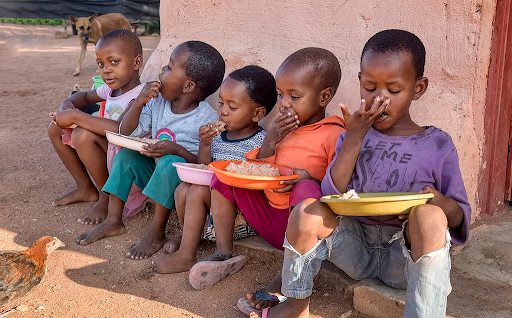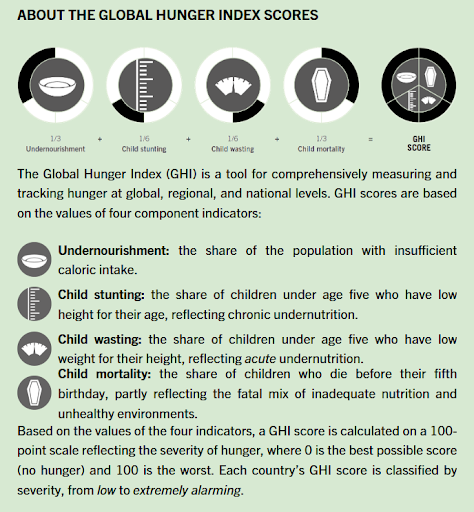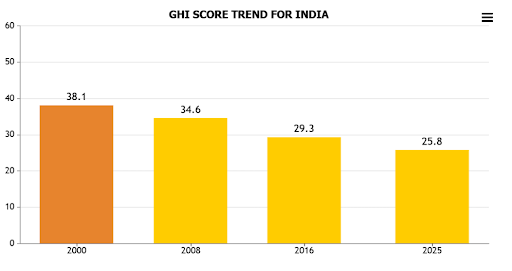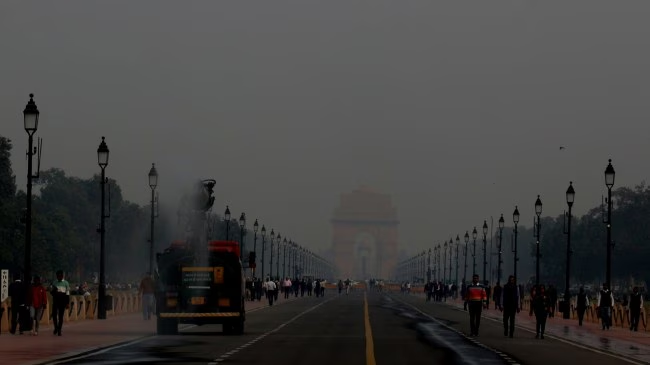



The 2025 Global Hunger Index shows hunger progress stalled since 2016, with 56 countries set to miss the 2030 'low' hunger target. India ranks 102nd with 'serious' hunger, primarily due to child malnutrition. Conflict and climate change are major factors, necessitating renewed global efforts for Zero Hunger.

Copyright infringement not intended
Picture Courtesy: DOWNTOEARTH
The 2025 Global Hunger Index (GHI) report reveals a troubling trajectory: rather than advancing towards the United Nations Sustainable Development Goal (SDG) of Zero Hunger by 2030, the world is experiencing a regression in several regions.
The GHI is a comprehensive, peer-reviewed annual report that measures and tracks hunger at the global, regional, and national levels.
It is published jointly by Concern Worldwide and Welthungerhilfe.
It is a multidimensional tool that captures three key aspects of hunger:
It calculates a score for each country based on four indicators:
Based on the score, hunger in each country is classified into five levels of severity: low, moderate, serious, alarming, and extremely alarming.

Global Stagnation
After a period of significant gains, global progress against hunger has largely stalled. The world's GHI score of 18.3 in 2025 is only a marginal improvement from 19.0 in 2016.
The 2030 Goal is Out of Reach
At the current pace, at least 56 countries are projected to miss even the "low hunger" threshold by 2030, making the goal of "Zero Hunger" a distant dream.
Hotspots of Severe Hunger
Hunger remains at "serious" or "alarming" levels in 42 countries. Seven countries are facing an alarming hunger crisis: Burundi, the Democratic Republic of Congo, Haiti, Madagascar, Somalia, South Sudan, and Yemen.
A Dangerous Reversal
Hunger levels have increased in 27 countries since 2016, reversing years of hard-won progress.
Regional Disparities
|
Region |
Status of Hunger |
Key Trends |
|
Africa South of the Sahara |
Serious (Highest in the world) |
Since 2016, progress has decelerated, with hunger increasing in ten countries, due to rise in the number of undernourished individuals, reaching critically high levels in nations such as the Democratic Republic of the Congo, Somalia, and Zambia. |
|
South Asia |
Serious |
This remains one of the hardest-hit regions, though some countries like India, Nepal, and Bangladesh have shown that targeted policies can drive meaningful progress. |
|
West Asia & North Africa |
Moderate |
Progress in reducing hunger has been very limited since 2016. |
|
Latin America & the Caribbean |
Moderate |
The pace of hunger reduction has slowed significantly. |
|
East & Southeast Asia |
Low |
This region continues to have low levels of hunger, but the pace of improvement has slowed. |
|
Europe & Central Asia |
Low (Lowest in the world) |
This region consistently records the lowest GHI scores. |


Conflict and Instability
Conflicts in areas such as Yemen, Gaza, and South Sudan are the main drivers of food insecurity, as they devastate infrastructure, uproot communities, and use hunger as a weapon.
Climate Change Impacts
Climate shocks like droughts and floods increasingly harm agricultural output, particularly for smallholder farmers in vulnerable areas, despite their minimal contribution to the climate crisis.
Economic Pressures and Political Inertia
COVID-19's economic impact, alongside rising food and fuel costs, deepened the crisis, worsened by a lack of political commitment to long-term food security.
Tajikistan
Once categorized as having "alarming" hunger levels, has made remarkable strides towards the "low" hunger threshold. This achievement highlights the effectiveness of sustained political commitment and targeted investments.
South Asian Success Stories (India, Bangladesh, and Nepal)
Nations like India, with its National Food Security Act and POSHAN Abhiyaan, and Bangladesh, by empowering women and innovating agriculture, demonstrate how targeted policies can reduce undernutrition.
The report cautions that these achievements need ongoing support, robust climate early-warning systems, and fundamental food system reorganization for lasting resilience.
The 2025 Global Hunger Index indicates the 2030 Zero Hunger goal is failing. Renewed international commitment is crucial to tackle conflict, climate change, and inequality—key hunger drivers. Tajikistan and Bangladesh demonstrate that with effective policies, investment, and political will, ending hunger is possible.
Source: DOWNTOEARTH
|
PRACTICE QUESTION Q. Climate change and hunger are deeply intertwined. Critically Analyze. 250 words |
The GHI is a peer-reviewed, annual report that tracks and measures hunger on a global, regional, and national scale. Published jointly by Concern Worldwide and Welthungerhilfe, it aims to raise awareness and track progress toward Sustainable Development Goal 2 (SDG 2), which targets "Zero Hunger" by 2030.
The GHI is jointly published by two European non-governmental organizations, Concern Worldwide (based in Ireland) and Welthungerhilfe (based in Germany)
The GHI combines four indicators to measure hunger: undernourishment, child stunting, child wasting, and child mortality. These indicators reflect the nutritional status of the population and children under five.




© 2025 iasgyan. All right reserved